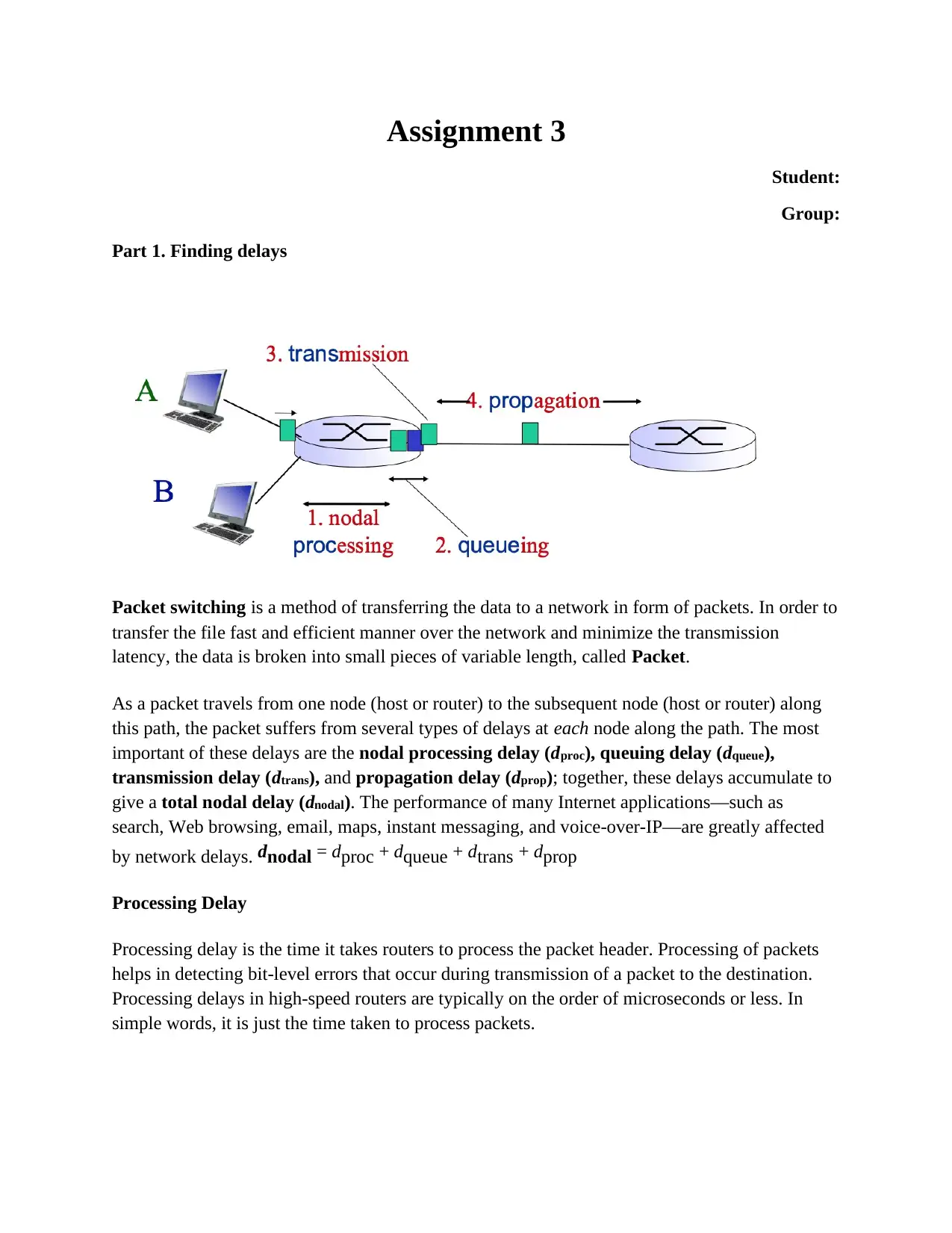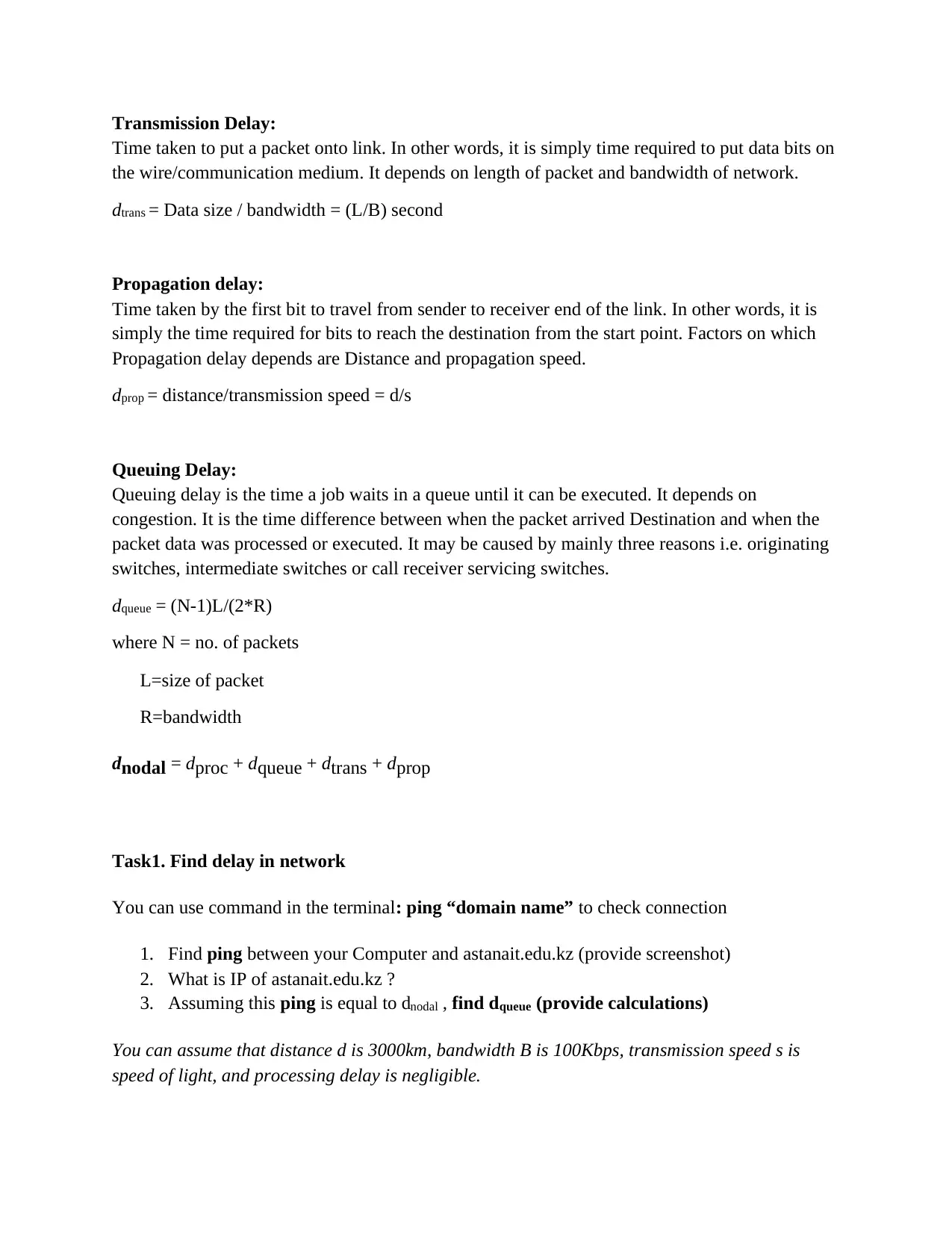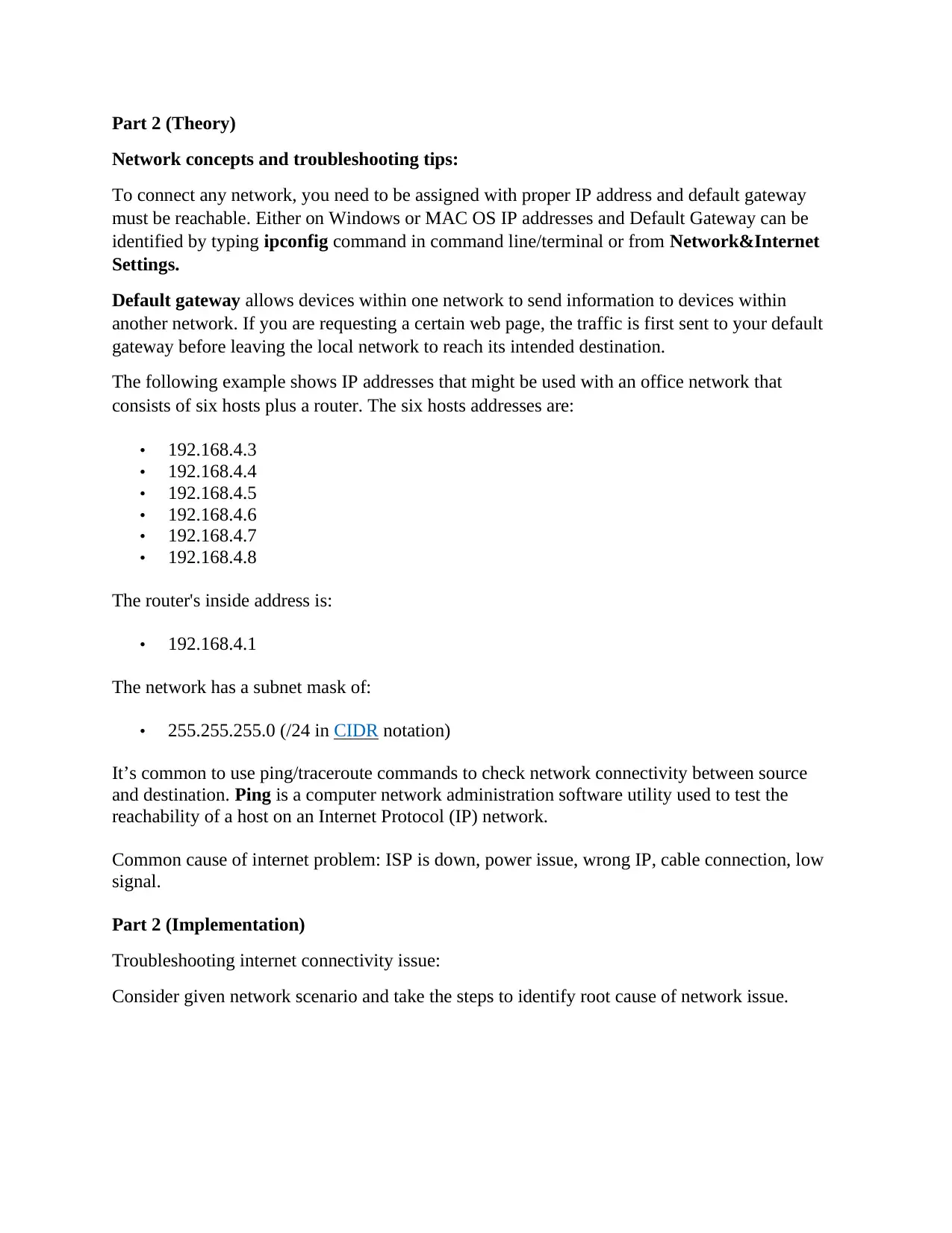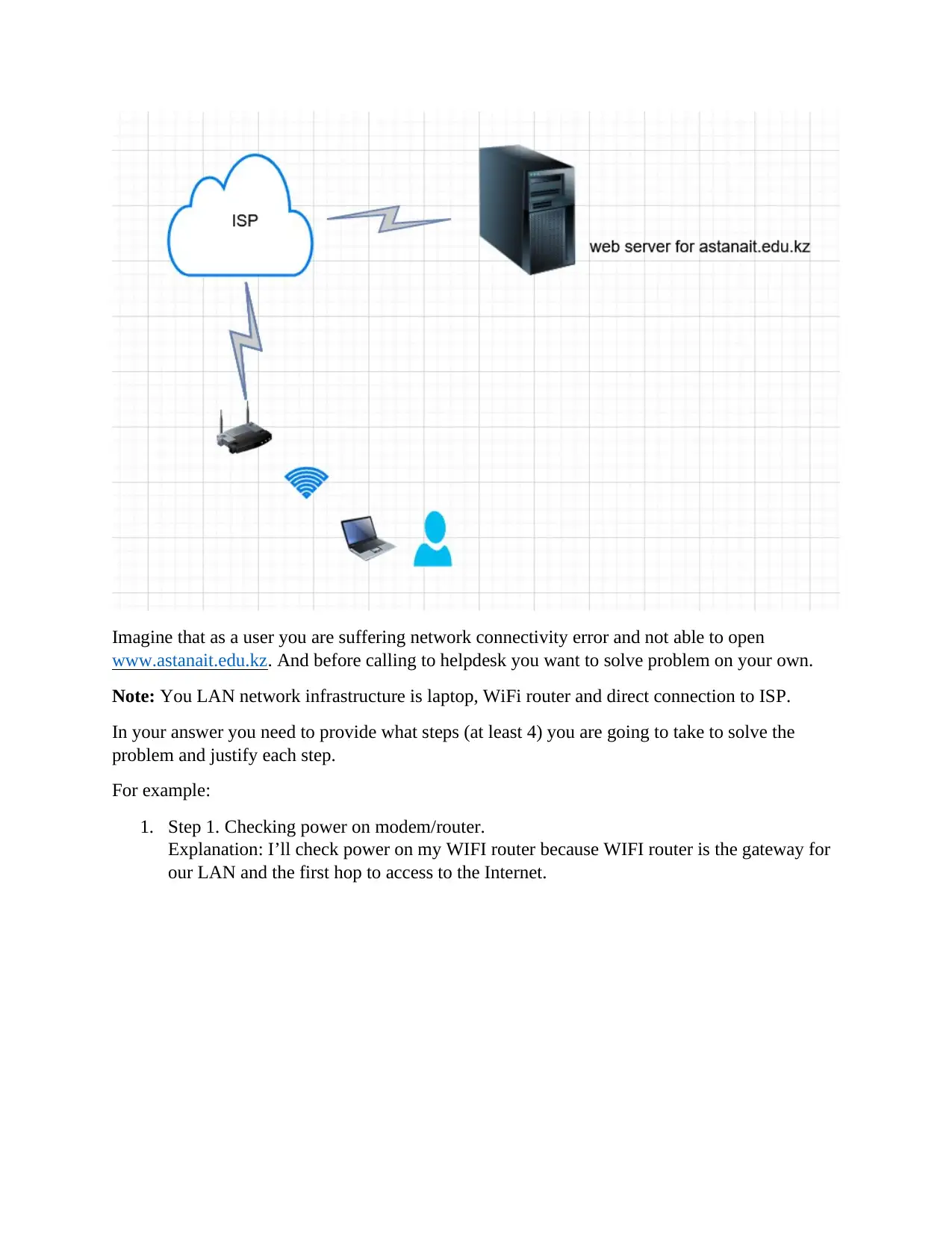Analysis of Network Delays, Troubleshooting, and OSI Model Mindmap
VerifiedAdded on 2020/10/12
|6
|1032
|139
Homework Assignment
AI Summary
This assignment delves into the intricacies of network delays, focusing on packet switching and the components of nodal delay (processing, queuing, transmission, and propagation). Students are tasked with using the ping command to measure delays, calculate queuing delays, and analyze differences in ping results. The assignment also covers network concepts, including IP addresses, default gateways, and common internet problems, and challenges students to troubleshoot a connectivity issue. Finally, students are required to create a mindmap of the OSI model, illustrating the layers and associated protocols. The assignment aims to provide a comprehensive understanding of network performance, troubleshooting, and the layered architecture of network communication.

Assignment 3
Student:
Group:
Part 1. Finding delays
Packet switching is a method of transferring the data to a network in form of packets. In order to
transfer the file fast and efficient manner over the network and minimize the transmission
latency, the data is broken into small pieces of variable length, called Packet.
As a packet travels from one node (host or router) to the subsequent node (host or router) along
this path, the packet suffers from several types of delays at each node along the path. The most
important of these delays are the nodal processing delay (dproc), queuing delay (dqueue),
transmission delay (dtrans), and propagation delay (dprop); together, these delays accumulate to
give a total nodal delay (dnodal). The performance of many Internet applications—such as
search, Web browsing, email, maps, instant messaging, and voice-over-IP—are greatly affected
by network delays. dnodal = dproc + dqueue + dtrans + dprop
Processing Delay
Processing delay is the time it takes routers to process the packet header. Processing of packets
helps in detecting bit-level errors that occur during transmission of a packet to the destination.
Processing delays in high-speed routers are typically on the order of microseconds or less. In
simple words, it is just the time taken to process packets.
Student:
Group:
Part 1. Finding delays
Packet switching is a method of transferring the data to a network in form of packets. In order to
transfer the file fast and efficient manner over the network and minimize the transmission
latency, the data is broken into small pieces of variable length, called Packet.
As a packet travels from one node (host or router) to the subsequent node (host or router) along
this path, the packet suffers from several types of delays at each node along the path. The most
important of these delays are the nodal processing delay (dproc), queuing delay (dqueue),
transmission delay (dtrans), and propagation delay (dprop); together, these delays accumulate to
give a total nodal delay (dnodal). The performance of many Internet applications—such as
search, Web browsing, email, maps, instant messaging, and voice-over-IP—are greatly affected
by network delays. dnodal = dproc + dqueue + dtrans + dprop
Processing Delay
Processing delay is the time it takes routers to process the packet header. Processing of packets
helps in detecting bit-level errors that occur during transmission of a packet to the destination.
Processing delays in high-speed routers are typically on the order of microseconds or less. In
simple words, it is just the time taken to process packets.
Paraphrase This Document
Need a fresh take? Get an instant paraphrase of this document with our AI Paraphraser

Transmission Delay:
Time taken to put a packet onto link. In other words, it is simply time required to put data bits on
the wire/communication medium. It depends on length of packet and bandwidth of network.
dtrans = Data size / bandwidth = (L/B) second
Propagation delay:
Time taken by the first bit to travel from sender to receiver end of the link. In other words, it is
simply the time required for bits to reach the destination from the start point. Factors on which
Propagation delay depends are Distance and propagation speed.
dprop = distance/transmission speed = d/s
Queuing Delay:
Queuing delay is the time a job waits in a queue until it can be executed. It depends on
congestion. It is the time difference between when the packet arrived Destination and when the
packet data was processed or executed. It may be caused by mainly three reasons i.e. originating
switches, intermediate switches or call receiver servicing switches.
dqueue = (N-1)L/(2*R)
where N = no. of packets
L=size of packet
R=bandwidth
dnodal = dproc + dqueue + dtrans + dprop
Task1. Find delay in network
You can use command in the terminal: ping “domain name” to check connection
1. Find ping between your Computer and astanait.edu.kz (provide screenshot)
2. What is IP of astanait.edu.kz ?
3. Assuming this ping is equal to dnodal , find dqueue (provide calculations)
You can assume that distance d is 3000km, bandwidth B is 100Kbps, transmission speed s is
speed of light, and processing delay is negligible.
Time taken to put a packet onto link. In other words, it is simply time required to put data bits on
the wire/communication medium. It depends on length of packet and bandwidth of network.
dtrans = Data size / bandwidth = (L/B) second
Propagation delay:
Time taken by the first bit to travel from sender to receiver end of the link. In other words, it is
simply the time required for bits to reach the destination from the start point. Factors on which
Propagation delay depends are Distance and propagation speed.
dprop = distance/transmission speed = d/s
Queuing Delay:
Queuing delay is the time a job waits in a queue until it can be executed. It depends on
congestion. It is the time difference between when the packet arrived Destination and when the
packet data was processed or executed. It may be caused by mainly three reasons i.e. originating
switches, intermediate switches or call receiver servicing switches.
dqueue = (N-1)L/(2*R)
where N = no. of packets
L=size of packet
R=bandwidth
dnodal = dproc + dqueue + dtrans + dprop
Task1. Find delay in network
You can use command in the terminal: ping “domain name” to check connection
1. Find ping between your Computer and astanait.edu.kz (provide screenshot)
2. What is IP of astanait.edu.kz ?
3. Assuming this ping is equal to dnodal , find dqueue (provide calculations)
You can assume that distance d is 3000km, bandwidth B is 100Kbps, transmission speed s is
speed of light, and processing delay is negligible.

4. Find ping between your Computer and huawei.com (provide sceenshot)
5. Why ping is different for astanait.edu.kz and huawei.com ?
5. Why ping is different for astanait.edu.kz and huawei.com ?
⊘ This is a preview!⊘
Do you want full access?
Subscribe today to unlock all pages.

Trusted by 1+ million students worldwide

Part 2 (Theory)
Network concepts and troubleshooting tips:
To connect any network, you need to be assigned with proper IP address and default gateway
must be reachable. Either on Windows or MAC OS IP addresses and Default Gateway can be
identified by typing ipconfig command in command line/terminal or from Network&Internet
Settings.
Default gateway allows devices within one network to send information to devices within
another network. If you are requesting a certain web page, the traffic is first sent to your default
gateway before leaving the local network to reach its intended destination.
The following example shows IP addresses that might be used with an office network that
consists of six hosts plus a router. The six hosts addresses are:
• 192.168.4.3
• 192.168.4.4
• 192.168.4.5
• 192.168.4.6
• 192.168.4.7
• 192.168.4.8
The router's inside address is:
• 192.168.4.1
The network has a subnet mask of:
• 255.255.255.0 (/24 in CIDR notation)
It’s common to use ping/traceroute commands to check network connectivity between source
and destination. Ping is a computer network administration software utility used to test the
reachability of a host on an Internet Protocol (IP) network.
Common cause of internet problem: ISP is down, power issue, wrong IP, cable connection, low
signal.
Part 2 (Implementation)
Troubleshooting internet connectivity issue:
Consider given network scenario and take the steps to identify root cause of network issue.
Network concepts and troubleshooting tips:
To connect any network, you need to be assigned with proper IP address and default gateway
must be reachable. Either on Windows or MAC OS IP addresses and Default Gateway can be
identified by typing ipconfig command in command line/terminal or from Network&Internet
Settings.
Default gateway allows devices within one network to send information to devices within
another network. If you are requesting a certain web page, the traffic is first sent to your default
gateway before leaving the local network to reach its intended destination.
The following example shows IP addresses that might be used with an office network that
consists of six hosts plus a router. The six hosts addresses are:
• 192.168.4.3
• 192.168.4.4
• 192.168.4.5
• 192.168.4.6
• 192.168.4.7
• 192.168.4.8
The router's inside address is:
• 192.168.4.1
The network has a subnet mask of:
• 255.255.255.0 (/24 in CIDR notation)
It’s common to use ping/traceroute commands to check network connectivity between source
and destination. Ping is a computer network administration software utility used to test the
reachability of a host on an Internet Protocol (IP) network.
Common cause of internet problem: ISP is down, power issue, wrong IP, cable connection, low
signal.
Part 2 (Implementation)
Troubleshooting internet connectivity issue:
Consider given network scenario and take the steps to identify root cause of network issue.
Paraphrase This Document
Need a fresh take? Get an instant paraphrase of this document with our AI Paraphraser

Imagine that as a user you are suffering network connectivity error and not able to open
www.astanait.edu.kz. And before calling to helpdesk you want to solve problem on your own.
Note: You LAN network infrastructure is laptop, WiFi router and direct connection to ISP.
In your answer you need to provide what steps (at least 4) you are going to take to solve the
problem and justify each step.
For example:
1. Step 1. Checking power on modem/router.
Explanation: I’ll check power on my WIFI router because WIFI router is the gateway for
our LAN and the first hop to access to the Internet.
www.astanait.edu.kz. And before calling to helpdesk you want to solve problem on your own.
Note: You LAN network infrastructure is laptop, WiFi router and direct connection to ISP.
In your answer you need to provide what steps (at least 4) you are going to take to solve the
problem and justify each step.
For example:
1. Step 1. Checking power on modem/router.
Explanation: I’ll check power on my WIFI router because WIFI router is the gateway for
our LAN and the first hop to access to the Internet.

Part 3. Drawing Mindmap of Communication Layers and Protocols
The ISO-OSI (International organization of Standardization – Open System Interconnection)
model is designed to represent communications that defines a networking framework for
implementing protocols in seven layers.
Task 1. Draw Mindmap (Layers+Protocols)
1. Draw mindmap using seven layers (OSI), write which protocols are related to each layer.
You should draw it by yourself, you can use any software you wish.
The ISO-OSI (International organization of Standardization – Open System Interconnection)
model is designed to represent communications that defines a networking framework for
implementing protocols in seven layers.
Task 1. Draw Mindmap (Layers+Protocols)
1. Draw mindmap using seven layers (OSI), write which protocols are related to each layer.
You should draw it by yourself, you can use any software you wish.
⊘ This is a preview!⊘
Do you want full access?
Subscribe today to unlock all pages.

Trusted by 1+ million students worldwide
1 out of 6
Related Documents
Your All-in-One AI-Powered Toolkit for Academic Success.
+13062052269
info@desklib.com
Available 24*7 on WhatsApp / Email
![[object Object]](/_next/static/media/star-bottom.7253800d.svg)
Unlock your academic potential
Copyright © 2020–2025 A2Z Services. All Rights Reserved. Developed and managed by ZUCOL.





